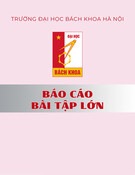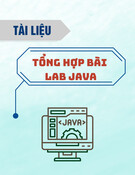Bài 4:
Layout và các điều khiển cơ bản
2016
Nội dung
I. Layout
1. Cách tạo một Layout mới.
2. Kết nối layout vào Activity
3. HierarchyViewer.
4. Các kiểu Layout cơ bản.
II. Các điều khiển cơ bản
2
1. Cách tạo một Layout mới
Chọn File New Android XML File Linear Layout (layout bạn muốn tạo – bạn có thể chọn Relative Layout, Table Layout, …).
3
2. Kết nối layout vào Activity
Code kết nối Layout vào Activity
4
3. HierarchyViewer
Một Layout phải được kết
nối vào Activity nào đó
thông
qua
hàm
setContentView, Android
sẽ có cơ chế dịch XML
thành Java code.
HierarchyViewer dùng để
hiển thị cấu trúc UI của
màn hình hiện tại
trên
emulator hoặc thiết bị
thật.
5
4. Các kiểu Layout cơ bản
FrameLayout
TableLinearLayout
Layout
RelativeLayout
AbsoluteLayout
6
Các thuộc tính
Required attributes
● layout_width
● layout_height
=> layout knows how to size a view
android:layout_height="wrap_content" android:layout_width="match_parent" (previously "fill_parent“)
*can be specified in a measurement unit
7
Các thuộc tính (tt)
Other common attributes
● Id (e.g., android:id=“@+id/startButton”)
● layout_marginTop
● layout_marginBottom
● layout_marginLeft
● layout_marginRight
● layout_gravity (alignment: i.e., left, center, right)
● layout_weight
● ...
8
Unit of Measurements
Concern: devices with different densities
(dpi, dot per inch)
Screen densities for Android
● Low density (ldpi): 120 dpi
● Medium density (mdpi): 160 dpi
● High density (hdpi): 240 dpi
● Extra high density (xhdpi): 320 dpi
● Extra extra high density (xxhdpi): 480 dpi
● Extra extra extra high density (xxxhdpi): 640 dpi
9
Different Units
dp: density-independent pixel
● 160dp = 1" of physical screen size
● dp to screen pixels (px): px = dp x (dpi / 160)
sp: scale-independent pixel
● Same ratio on different devices; recommended
pt: point
● 1 pt = 1/72" of physical screen size; not recommended
px: pixel
● Similar to dp for specifying font size; recommended
● Actual pixel of screen; not recommended
10
Các loại Layout
Layout thường sử dụng:
RelativeLayout
LinearLayout
TableLayout
GridLayout
FrameLayout
11
12
FrameLayout
Sử dụng trong các trường hợp xây dựng bố cục tổ
chức hiển thị một đối tượng duy nhất.
Đối tượng mặc định vị trí top-left trên FrameLayout, có thể sử dụng thuộc tính Gravity để thiết lập lại vị trí.
Ví dụ khai báo:
xmlns:android="http://schemas.android.com/apk/res/android" android:layout_width="match_parent"
android:layout_height="match_parent” > Các đối tượng kế thừa phổ biến: ● ViewFlipper: đối tượng cho phép thực hiện hiển thị các đối
tượng ở chế độ phân trang, chỉ hiển thị một đối tượng ở một
thời điểm. Ví dụ khai báo: xmlns:android="http://schemas.android.com/apk/res/android"
android:layout_width="match_parent"
android:layout_height="match_parent” > Các phương thức sử dụng: startFlipping
setAutoStart
showNext
showPrevious Các đối tượng kế thừa phổ biến: ● ScrollView: đối tượng cho phép thực hiện hiển thị các đối
tượng ở chế độ cuộn màn hình, chỉ cho phép chứa một đối
tượng ở một thời điểm.
Ví dụ khai báo: xmlns:android="http://schemas.android.com/apk/res/android" android:layout_width="match_parent" android:layout_height="match_parent” > Các phương thức sử dụng: setFillViewPort scrollBy scrollTo smoothScrollBy smoothScrollTo Sử dụng trong các trường hợp xây dựng bố cục tổ Ví dụ khai báo: android:layout_width="match_parent"
android:layout_height="match_parent” xmlns:android="http://schemas.android.com/apk/res/android" android:orientation=“vertical” > TableLayout: đối tượng layout kế thừa từ Mỗi dòng có thể chứa nhiều View, mỗi View được xem xmlns:android="http://schemas.android.com/apk/res/android" android:layout_width="match_parent"
android:layout_height="match_parent” > TableRow sẽ tự động được tạo ra (nếu dòng đó chưa có) khi bạn kéo thả
các View con vào các ô của bảng. Ví dụ khai báo:
xmlns:android="http://schemas.android.com/apk/res/android" android:layout_width="match_parent"
android:layout_height="match_parent”> Types of relationships: ● To the left, right, above or below the specified element (layout_toLeftOf, layout_toRightOf, layout_above,
layout_below) ● Aligned by the left, right, top or bottom edge of the specified element (layout_alignLeft, layout_alignRight,
layout_alignTop, layout_alignBottom) ● Aligned by the left, right, top or bottom edge of a parent (layout_alignParentLeft, layout_alignParentRight,
layout_alignParentTop, layout_alignParentBottom)
● Centered vertically, centered horizontally, centered
vertically and horizontally relative to its parent
(layout_centerVertical, layout_centerHorizontal,
layout_centerInParent) Horizontal vs vertical orientation android:columnCount=“2”
android:rowCount=“2”
android:orientation=“horizontal”>
Placeholder on screen that can be Multiple views stacked in a frame Các điều khiển là các thành phần giao diện của ứng dụng. Làm nhiệm vụ chuyển tải thông tin hoặc tiếp nhận thông tin Ví dụ: Button, TextView, từ người dùng cuối. ImageView, EditText, CheckBox, RadioButton, RadioGroup, ToggleButton, ProgressBar, … http://developer.android.com/guide/topics/ui/controls.html TextView: primarily for text output
EditText: text input and editing by the user using (soft) keyboard Button được xây dựng từ TextView. Button cho phép nhận Các dạng Button: • Button • CompoundButton: và phản hồi tương tác nhấn từ người dùng. CheckBox, RadioButton, Cách lấy button theo Id của Button Cách thiết lập sự kiện cho Button Normal: dạng văn bản kích thước font chữ mặc đinh.
SmallText: dạng văn bản kích thước font chữ nhỏ.
MediumText: dạng văn bản kích thước font chữ vừa.
LargeText: dạng văn bản kích thước font chữ to. Plain text none Person name textPersonName Password textPassword Password (Numeric)
E-mail numberPassword
textEmailAddress Phone phone Postal address textPostalAddress androd:hint=“email address”
android:inputType=“textEmailAddress” /> Basic views: simple, commonly used views, e.g., Picker views: views for selecting from a list, e.g., List views: views for displaying a long list of items, A radio button is specifically used when a single item from a collection of items must be made. Containers (view group) for other views, e.g., ● GridView: items displayed in a two-dimensional scrolling grid. ● ListView: items displayed in a vertically scrolling list ● ExpandableListView: extension of a ListView to support two levels ● … Challenge ● Many different data sources, e.g., arrays, collections, and database and GridView ● Many different ways of displaying them, e.g., Spinner, ListView, ● Q: How to bind them together? ● Q: Any design pattern for this? Bind a data source to an container view (AdapterView) Provides a common interface to the data model behind an AdapterView Responsible for accessing the data to be supplied to a container widget Behaves as a middleman between the data source and the adapterView. array Display a list of items in a vertically scrolling list Providing a list of data to display ListAdapter: subinterface of Adapter with many subclasses ● BaseAdapter (abstract) ● CursorAdapter (abstract) ● SimpleBaseAdapter ● SimpleCursorAdapter ● … Listener: OnItemSelectedListener Customization ● setChoiceMode(int): none (ListView.CHOICE_MODE_NONE), single, multiple ● setTextFilterEnabled(boolean): let the view filter to match what is typed on the keypad ● setItemChecked(int, boolean) Storing and retrieving items from strings.xml Bước 1: Đưa dữ liệu cần hiển thị lên ListView vào một mảng Bước 2: Tạo một ListView trên giao diện. Bước 3: Tạo một đối tượng ArrayAdapter để liên kết giữ tượng,…). ListView và mảng hoặc danh sách dữ liệu. ArrayAdapter là gì? ListView có thể “đọc và hiểu” dữ liệu từ mảng dữ liệu để hiện lên giao diện. Lấy ListView thông qua Id của ListView Tạo ArrayAdapter Đưa dữ liệu từ mảng vào ArrayAdapter ArrayAdapter<[Kiểu mảng]>[Tên mảng adapter]; [Tên mảng adapter] = new ArrayAdapter Cách đổ dữ liệu lên ListView (this,android.R.layout.simple_list_item_1,[tenMangDuLieu]); lvTenLV.setAdapter(tenMangAdapter);13
FrameLayout
14
FrameLayout
15
LinearLayout
chức hiển thị các đối tượng theo một chiều duy nhất
(chiều dọc hoặc ngang)
(android:orientation="horizontal" or "vertical")
Đối tượng mặc định vị trí top left trên LinearLayout, có
thể sử dụng thuộc tính Gravity để thiết lập lại vị trí.
16
LinearLayout
17
TableLayout
LinearLayout, cho phép hiển thị các đối tượng theo
nhiều dòng (TableRow).
là một cột.
Ví dụ khai báo:
18
TableLayout
19
RelativeLayout
Sử dụng trong các trường hợp xây dựng bố cục tổ
chức hiển thị các đối tượng theo mối quan hệ vị trí.
Đối tượng được đặt vào RelativeLayout đầu tiên sẽ xác
định vị trí cho các đối tượng sau đó.
20
RelativeLayout
21
android:layout_alignParentTop=“true”
android:layout_alignParentLeft=“true”
android:layout_alignParentStart=“true”
android:layout_toRightOf=“@id/text2”
android:layout_alignBottom=“@id/text2”
android:layout_below=“@id/text1”
android:layout_alignLeft=“@id/text1”
android:layout_alignStart=“@id/text1”
android:layout_below=“@id/button”
android:layout_alignLeft=“@id/button”
android:layout_alignStart=“@id/button”
22
GridLayout
Places its children in a rectangular grid
Can place children quickly without requiring a table
Can place children in a controlled way by specifying
a row-and-column location or using layout_row and
layout_column attribute
23
FrameLayout
used to display a single view.
layout, i.e., position children on top of
each other.
24
Xem thêm:
http://developer.android.com/guide/topics/ui/declarin
g-layout.html
25
Nội dung
I. Layout
II. Các điều khiển cơ bản
1. Button
2. TextView
3. EditText
4. RadioButton – RadioGroup
5. ListView
26
II. Các điều khiển cơ bản
27
Text Input and Output
View
TextView
EditText
1. Button
ToggleButton, Switch.
29
1. Button
30
2. TextView
TextView là đối tượng cho phép hiển thị các nội dung văn
bản ở 4 dạng:
31
2. TextView
32
3. EditText
Text Field
inputType Property Value
33
Views and Widgets
Many different views and widgets
TextView, EditText, and Button
TimePicker and DatePicker
e.g., Spinner and ListView
Container views: views containing other views, e.g.,
RadioGroup, GridView, ScrollView, and VideoView.
34
35
4. RadioGroup and RadioButton
If a radio button is already selected, it will be de-selected
when another radio button in the collection is selected.
36
Container Views
37
Providing Data to Container Views
Array
List
Database
…
38
Adapter
such as ListView
and converting the individual elements of data into a specific view
<
AdapterView
ListView
ArrayAdapter
39
5. ListView
setAdaper(ListAdapter)
including:
● ArrayAdapter
40
5. ListView (Cont.)
getResources().getStringArray(R.array.my_array)
41
Các bước thực hiện để sử dụng ListView
hoặc danh sách (ArrayList, mảng thông thường, mảng đối
ArrayAdapter được hiểu như cái modem mạng. Nó giúp
Các xử lý trên ListView
ListView lvTenLV = (ListView) findViewById(R.id.idcuaListView);
44





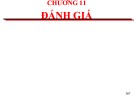
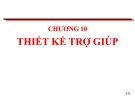

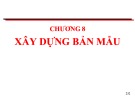
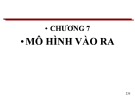
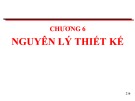
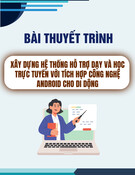
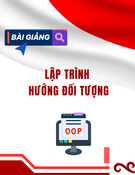
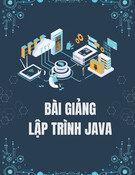
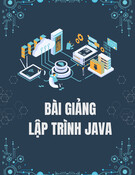
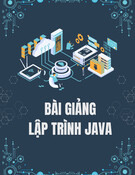
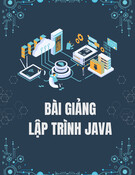
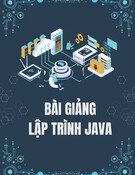

![Hệ thống quản lý cửa hàng bán thức ăn nhanh: Bài tập lớn [chuẩn nhất]](https://cdn.tailieu.vn/images/document/thumbnail/2025/20251112/nguyenhuan6724@gmail.com/135x160/54361762936114.jpg)
![Bộ câu hỏi trắc nghiệm Nhập môn Công nghệ phần mềm [mới nhất]](https://cdn.tailieu.vn/images/document/thumbnail/2025/20251111/nguyenhoangkhang07207@gmail.com/135x160/20831762916734.jpg)


